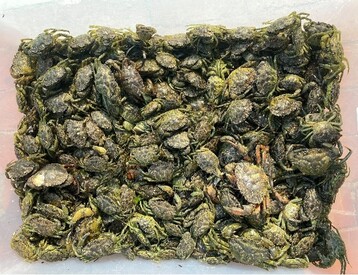Current Sea: Green Crabs Continue Their Invasion Of Nantucket
Jack Dubinsky •

Armed with two claws, a hard carapace, and an insatiable appetite, the European green crabs (Carcinus maenas) continue their invasion of Nantucket. Green crabs are often cited as one of the top 5 most invasive marine species in the world. Native to northern and western Europe, green crabs have established populations on 6 continents, including both the East and West coasts of the United States.
Green crabs were first spotted in New England in the early 1800s. They were likely accidentally introduced after hitching a ride on shipping vessels from Europe. Since then, green crabs have increased drastically and are now abundant from Nova Scotia to the Chesapeake Bay.
Here on Nantucket, green crabs have a wide range of impacts.
- As green crabs explore our harbors, they can damage the root systems of eelgrass, making them more vulnerable to being uprooted during inclement weather. The eelgrass is a vital habitat for several species of fish, crabs, shrimp and the struggling Atlantic bay scallops (Argopecten irradians).
- Green crabs are very efficient predators of shellfish. Juvenile green crabs are fond of eating soft-shell clams (Mya arenaria), bay scallops, and other bivalves. This adds pressure to these populations that are already enduring the effects of human harvest and ocean acidification.
- Green crabs are outcompeting native crab species. For example, when a tasty dead fish sinks to the bottom of the harbor, the keen green crabs often get to the food before the slow spider crabs (Libinia emarginata), nocturnal lady crabs (Ovalipes ocellatus), and relatively small long-claw hermit crabs (Pagurus longicarpus).

Data collected during the Maria Mitchell Association Marine Ecology Field Trips suggests that green crab populations are slowly increasing, while several native crab species are slowly declining. Green crabs have few predators on Nantucket. Although Chesapeake Blue Crabs (Callinectes sapidus) eat green crabs, there are not enough of them to control the green crab population and blue crabs prefer to stay near salt marshes, limiting the overlap between the two species. Anecdotal surveys of seagull midden on Nantucket docks suggest that very few green crabs succumb to predation from birds, whereas local crabs such as spider crabs, lady crabs, and rock crabs are frequently taken by avian predators. In their native habitat, the green crab population is controlled by a gruesome parasitic barnacle known as the crab hacker barnacle (Sacculina carcini). During infection, the barnacle castrates infected green crabs and tricks their host crab into brooding their eggs instead! Unfortunately, no such parasite exists in our area and scientists predict introducing the barnacle here would cause devastating collateral damage to local crustaceans.
In response to this threat, several non-profits on Nantucket have green crabs monitoring, research, and control initiatives. If you would like to help us monitor and remove green crabs, you can participate in the Nantucket Green Crab Community Science Survey. This year, surveyors have already counted and removed over 900 green crabs from Nantucket! After your survey, you can use the crabs as fishing bait, use them to make fertilizer, donate them to the Maria Mitchell Aquarium, or eat them (Figure 2)!
If you would like to learn more about green crabs and help with efforts to combat them, you are welcome to join the Maria Mitchell Association for the 2023 Nantucket Green Crab Week (August 7th – August 11th) featuring all sorts of fun green crab activities and events, including an identification workshop, survey trainings, and more! The week culminates with the 3rd annual Nantucket Green Crab Derby where teams compete to catch the most green crabs (figure 3)!